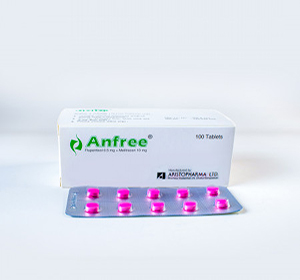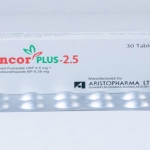Anfree (Flupentixol + Melitracen)
Description
Flupentixol-a neuroleptic with anxiolytic and antidepressant properties of its own when given in small doses, and Melitracen – a bipolar thymoleptic with activating properties in low doses. In combination, the compounds render a preparation with antidepressant, anxiolytic and activating properties. Maximum serum concentration is reached in about 4 hours after oral administration of Flupentixol and in about 4 hours after oral administration of Melitracen. The biological half-life of Flupentixol is about 35 hours and that of Melitracen is about 19 hours. The combination of Flupentixol and Melitracen does not seem to influence the pharmacokinetic properties of the individual compounds.

Presentation
Anfree Tablet: Each tablet contains Flupentixol Dihyrochloride BP equivalent to Flupentixol 0.5 mg and Melitracen Hydrochloride INN equivalent to Melitracen 10 mg.
Indications
Different types of anxiety, depression & apathy. These include- psychogenic depression, depressive neuroses, masked depression, psychosomatic affections accompanied by anxiety and apathy, menopausal depressions, dysphoria and depression in alcoholics and drug-addicts. Various recent studies show that Anfree can be successfully used for the treatment of anxiety-induced peptic ulcer diseases without H. pylori infection and functional dyspepsia in combination with antiulcerants and gastroprokinetics, aphthous ulcer in combination with triamcinolone, and trigeminal neuralgia.
Dosage & Administration
Adults : Usually 1 tablet twice daily; morning and noon. In severe cases the morning dose may be increased to 2 tablets
Elderly : 1 tablet in the morning. Maintenance dose: Usually 1 tablet in the morning.
In cases of insomnia or severe restlessness additional treatment with a sedative in the acute phase is recommended.
Contrainidications
Flupentixol-Melitracen is contraindicated in the immediate recovery phase after myocardial infarction; defects in bundle-branch conduction; untreated narrow angle glaucoma; acute alcohol, barbiturate and opiate intoxications; severe liver failure; for patients who received a MAO-inhibitor within two weeks and excitable or overactive patients.
Warning & Precautions
When replacing a tranquilizer by Anfree , the dosage of the tranquilizer should be stopped by gradually decreasing its dose alongside taking Anfree. Like other psychotropic drugs, Anfree can cause seizures in epilepsy. Treatment with Anfree should be suspended if hyperthermia occurs because this hyperthermia may be an element of neuroleptic malignant syndrome (pallor, hyperthermia, autonomic problems) associated with neuroleptics. Anfree should be administered carefully in prostatic hypertrophy, severe renal impairment, Parkinson’s disease and hyperthyroidism.
Side effects
Occasionally, some difficulty in sleeping may occur and that disappears after a few days of treatment. Rarely occurring side effects are dizziness, tremor, headache, blurred vision, hyperprolactinemia and anticholinergic effects.
Drug interaction
Flupentixol-Melitracen may enhance the effect of alcohol, barbiturates, and other CNS depressants. Simultaneous administration of MAO-inhibitors may cause hypertensive crises. Flupentixol-Melitracen reduces the antihypertensive effect of guanethidine and similar acting compounds. Melitracen enhances the effects of adrenaline and noradrenaline. Flupentixol may increase anticholinergic effects of anticholinergic drugs.
Use in special groups
Anfree should be avoided unless the expected benefit to the patient outweighs the potential risk to the foetus. Nursing mothers must stop breast feeding while taking Anfree.
Packing
Anfree Tablet: Each box contains 100’s tablets in blister pack.



